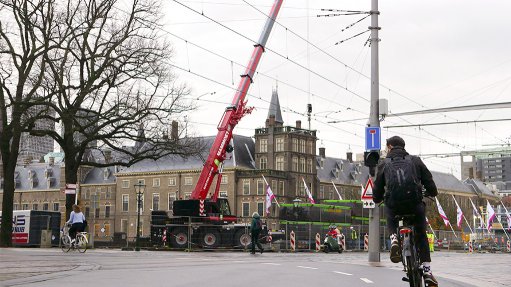
Mammoet zero emission heavy lifting equipment
Recent technological developments now make the electrification of heavy lifting and transportation equipment a possibility.
Heavy lifting and transportation specialist Mammoet says it views sustainability as an important factor in the future of its industry and says it can now offer a whole project solution without tailpipe emissions, using equipment that it has already introduced to the market.
Mammoet head of sustainability Mathias Hoogstra notes that government legislation and conditions built into tendering processes are weighted towards solutions that adhere to zero emissions.
“If you want to be a leader in the market, in my opinion, you must ensure that you are leading this whole transition and are at the forefront for your customers,” Hoogstra says.
Mammoet sales manager: civil sector Rafael Martinez has noticed the requirement for sustainable heavy lifting and transport growing.
“Low- or zero-emission conditions are becoming more common these days. There are sometimes very specific needs to drive down the carbon impact of projects, originated by local particularities or restrictions by public entities, like projects within congested urban environments, or environmentally protected areas. In Europe, this is something we are already seeing for tunnels," he explains.
Mammoet says it has been investing in ways to make its equipment less diesel-reliant, to give its customers greater choice in alternative power sources and benefits such as easier permitting procedures and a lower cost of borrowing.
The company says its focus in the civil sector is to make sure that the movements of large items, such as viaducts and bridges, can be carried out with zero emissions using hydraulics that are powered by electricity.
Mammoet explains that its self-propelled modular transporters (SPMTs) play a key part in many heavy lifting projects, leading it to focus on electrifying this equipment to offer a net-zero heavy-transport solution. The company explains that it consulted with a supplier to make an existing diesel power pack fully electric, noting that there is no significant difference in capabilities between electric- and diesel-powered SPMTs, with both offering an industry-standard 40 t/axle line.
The electric power pack units are the same size and fit in the same position on the transporters. They also operate in the same way, driving the hydraulics and powertrain.
The pack can be charged from 0% to 100% in approximately five-and-a-half hours, meaning it can charge overnight.
Mammoet global sustainability adviser Niek Bezuijen notes that existing equipment can be upgraded and retrofitted to be made electric, which contributes to waste reduction.
The company says it has engineered zero-emission offshore wind and onshore wind electric-powered cranes, and the SK series of cranes is notable among ring cranes in that its hydraulics run from an electric motor, powered by a generator. It recently developed a 100 t mobile crane that boasts a fully electric cab fitted with a 105 kWh battery, allowing for operation for a full working day.
Mammoet asserts that it wants to support heavy industry to find energy savings to offset the potential costs of going green and Hoogstra says he believes the transition to electric-, hydrogen- and biofuel-powered equipment is key.
“In previous years, we were looking to reduce usage of diesel on site. Now, we are taking a step further to monitor energy usage in an electric power environment and actively steer on efficient execution.
“We are conducting tests with our range of electric equipment to determine typical power usage per shift. This will help our customers to put appropriate and cost-effective electricity infrastructure in place, best suited to the project at hand.”